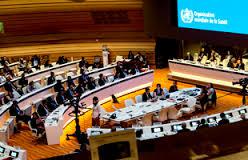
Delegates at the World Health Assembly agreed to implement 2 new health strategies that are closely aligned with the Sustainable Development Goals. One relates to women’s children’s and adolescents’ health; the other to healthy ageing.
Global Strategy for Women’s, Children’s and Adolescents’ Health
Delegates committed to take forward the implementation of Global Strategy for Women’s, Children’s and Adolescents’ Health (2016-2030).
The strategy sets out to ensure every woman, child and adolescent, in any setting, anywhere in the world, is able to both survive and thrive by 2030.
The strategy, and the new operational framework, place a strong emphasis on country leadership. They highlight the need to strengthen accountability at all levels through monitoring national progress and increasing capacity to collect and analyse data. They underscore the importance of developing a sustainable evidence-informed health financing strategy, as well as strengthening health systems and building partnerships with a wide range of actors across different sectors.
Today’s resolution calls on the WHO Secretariat to provide technical support to Member States in updating and implementing their national plans and to report regularly to the World Health Assembly on progress towards women’s, children’s and adolescents’ health. It also requests the Secretariat to continue to collaborate with other UN agencies and partners to advocate and leverage assistance so that national plans can be implemented.
Towards a world in which everyone can live a long and healthy life
Delegates also approved a resolution on the global strategy and action plan on ageing and health 2016-2020. In May 2014 the World Health Assembly asked the Director-General to develop a comprehensive global strategy and plan of action, to address the world’s rapidly ageing populations.
The proportion of the world’s population aged 60 years or over is predicted to double between 2000 and 2050, rising to 22%. A WHO report released in October 2015 revealed little evidence that older people today are experiencing better health than their parents did at the same age. Moreover, good health in older age is unequally distributed, both within and between countries. Most health problems are linked to chronic conditions, particularly noncommunicable diseases that can be prevented or delayed by healthy behaviours across the life-course.
The aim of the strategy is for every country to commit to action on healthy ageing. It calls for the development of age-friendly environments and the alignment of health systems to the needs of older populations. It envisages the development of sustainable and equitable systems of long-term care, and improved measurement, monitoring and research. It emphasizes equity and human rights, including the important role of involving older adults in all decisions that concern them.
Source: WHO
 FR
FR EN
EN AR
AR








